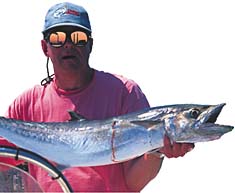|
Heavy Metal Blunder
By Charles Dukes
 It is all but invisible and must be measured with sensitive scientific equipment. Still, scientists assert there is more than enough
atmospheric mercury falling upon East Texas to explain elevated
mercury levels found in gamefish in some East Texas lakes. It is all but invisible and must be measured with sensitive scientific equipment. Still, scientists assert there is more than enough
atmospheric mercury falling upon East Texas to explain elevated
mercury levels found in gamefish in some East Texas lakes.
Now marine species, including the Gulf of Mexico's king mackerel,
have been added to the growing list of fish consumption advisories
issued to protect the public health in Texas, Florida and other
Gulf Coast states.
Raw data from a Mercury Deposition Network (MDN) test site at
Gregg County Airport near Longview indicates a similar amount
of airborne mercury is falling on East Texas, as it is at other
sites in the U.S. and Canada-where mercury contamination in fish
has long been recognized, including places for which there are
no known point-sources of contamination.
Data collected February 1996-97 at the Longview site, established
by the Texas Natural Resource Conservation Commission (TNRCC)
in cooperation with the National Atmospheric Deposition Program
(NADP), indicates that Texas is getting more than enough mercury
(8 to 11 micrograms per-meter-squared per year) from atmospheric deposition to explain levels of methylmercury
found in the edible flesh of freshwater fish in East Texas lakes
and in king mackerel in the Gulf of Mexico. Atmospheric deposition
is believed responsible for elevated mercury levels found in king
mackerel off the Texas Gulf Coast that resulted in the June 1997
issuance of a fish consumption advisory by the Texas Department of Health.
The TDH advises no consumption of king mackerel longer than 43 inches, and limits consumption of king mackerel with lengths of 37 to 43 inches to one 8-ounce serving per week for adults and one 8-ounce serving per month for children and for women of
childbearing age. The advisory does not restrict consumption of
king mackerel under 37 inches long, nor does it apply to any other
mackerel species, including those sold commercially in food stores.
The king mackerel lengths roughly correspond to expected mercury
levels of 1.5 parts per million (ppm) or more in the edible flesh
of king mackerel over 43 inches; 0.5-1.5 ppm in mid-length king
mackerel; and less than 0.5 ppm in king mackerel less than 37
inches, according to Kirk Wiles, an avid offshore angler and assistant
director of the TDH Seafood Safety Division.
Wiles urges anglers to take advisories very seriously, but added,
"This does not mean anyone who occasionally eats more king
mackerel than recommended definitely will suffer adverse health
effects. We're concerned primarily with children, females of childbearing
age, and anyone who regularly consumes the larger king mackerel."
While the Texas advisory applies to king mackerel only, the
federal Food and Drug Administration (FDA) on Feb. 16, 1994, issued
a chemical hazard alert for bonito, halibut, Spanish mackerel,
king mackerel, shark, marlin, and blue tuna based on a federal action
level of 1 ppm mercury in the edible flesh of food fish bound
for market. A debate is ongoing in federal circles as to whether
the action level should be lowered to 0.5 ppm or somewhat higher,
but less than 1 ppm.
Current advisories in Florida cover selected species in certain
areas including: gafftopsail catfish, jack crevalle, spotted seatrout
(speckled trout), ladyfish (skipjacks or "horse mackerel"),
Spanish mackerel and-in places like Tampa Bay, Florida Bay, Charlotte
Harbor and Indian River Lagoon-sharks. Their king mackerel advisory
is for the west coast of Florida. Their advisories cover freshwater
gamefish in a state where largemouth bass mercury levels have
been measured as high as 4.4 ppm.
Methylmercury, more toxic than elemental mercury or most other
forms (or species) of mercury, is the form of mercury most harmful
to fish, wildlife and humans. Humans are most often exposed to
mercury through consumption of fish. However, natives of the Faroe
Islands, Arctic regions and Northern Canada have been exposed
through consumption of seals and whales.
According to a Draft (June 1996) Mercury Study Report to Congress
being prepared by the U.S. Environmental Protection Agency (EPA),
scientists believe mercury in sediments and water bioaccumulates
in small plants and animals in lakes, rivers and oceans before
biomagnifying up the food chain when small plants and animals
are consumed by larger predators, including man. Experts said
biomagnification in animals may result in mercury levels in animals
up to 1 million times higher than in the water column they live
in or drink from.
continued
page 1 / page 2
| 




